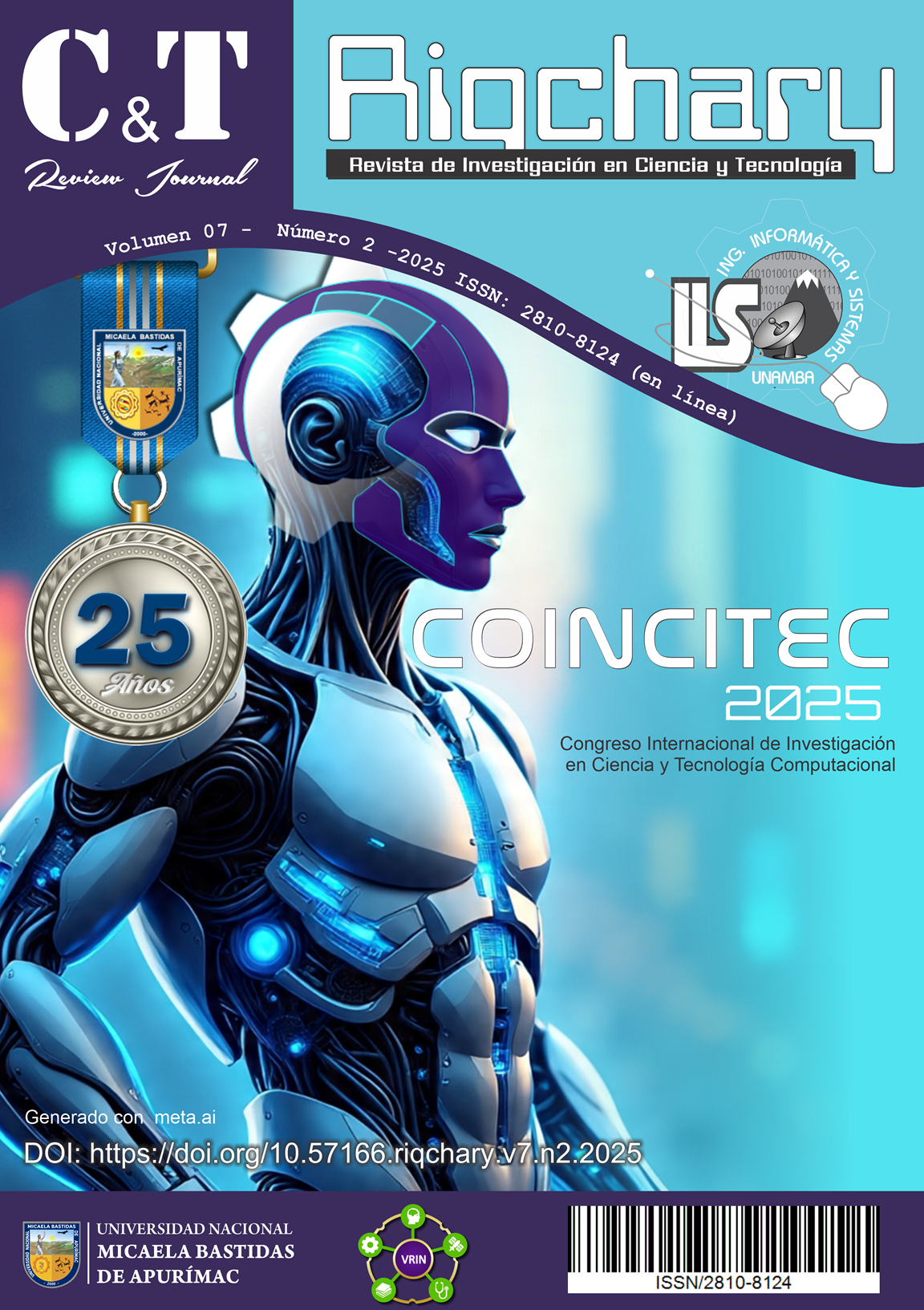Conjunctivitis detection from ocular images using CNN architectures and a fusion model
Main Article Content
Abstract
Conjunctivitis is a common cause of ophthalmologic consultation and may lead to serious complications if not diagnosed early. This study evaluates three pretrained convolutional neural network architectures—EfficientNetB0, InceptionV3, and ResNet50—for the automated classification of ocular images with and without signs of conjunctivitis. Additionally, a fusion model combining intermediate outputs from InceptionV3 and ResNet50 is proposed. All models were trained using GPU acceleration and employed regularization and data augmentation techniques. InceptionV3 achieved the best overall performance, with an accuracy of 95.00% and a precision of 0.98 for the positive class and 0.92 for the negative class, showing a solid balance between sensitivity and specificity. EfficientNetB0 achieved the highest recall in the positive class and the lowest false negative rate, although with considerably lower precision. ResNet50 obtained the lowest false positive rate, making it valuable for reducing misdiagnosis in negative cases. The fusion model achieved competitive metrics and a reduced training time, indicating that combining complementary architectures can enhance system robustness. This work provides a practical and reproducible guide for selecting CNN models for automated conjunctivitis diagnosis, particularly in resource-limited medical settings.
Article Details

This work is licensed under a Creative Commons Attribution-NonCommercial-NoDerivatives 4.0 International License.
When an author creates an article and publishes it in a journal, the copyright passes to the journal as part of the publishing agreement. Therefore, the journal becomes the owner of the rights to reproduce, distribute and sell the article. The author retains some rights, such as the right to be recognized as the creator of the article and the right to use the article for his or her own scholarly or research purposes, unless otherwise agreed in the publication agreement.
How to Cite
References
A. Y. Cheung, D. S. Choi, S. Ahmad, G. Amescua, V. Jhanji, A. Lin, S. I. Mian, M. K. Rhee, E. T. Viri-ya, F. S. Mah y D. M. Varu; American Academy of Ophthalmology Preferred Practice Pattern Cor-nea/External Disease Panel, “Conjunctivitis Pre-ferred Practice Pattern,” Ophthalmology, vol. 131, no. 4, pp. P134–P204, Apr. 2024. doi:10.1016/j.ophtha.2023.12.037.
M. Teweldemedhin, H. Gebreyesus, A. H. Atsbaha, S. W. Asgedom, and M. Saravanan, “Bacterial profile of ocular infections: A systematic review,” BMC Ophthalmol., vol. 17, no. 1, pp. 1–9, 2017, doi: 10.1186/s12886-017-0612-2.
D. S. W. Ting, C. Y. Cheung, G. Lim, N. M. Hsu, W. H. Tan, et al., “Development and Validation of a Deep Learning System for Diabetic Retinopathy and Related Eye Diseases Using Retinal Images From Multiethnic Populations With Diabetes,” JAMA, vol. 318, no. 22, pp. 2211–2223, Dec. 2017, doi:10.1001/jama.2017.18152.
S. Mondal, S. Banerjee, S. Mukherjee, A. Ganguly, and D. Sengupta, “Deep Classifier for Conjunctivitis – A Three-Fold Binary Approach,” Int. J. Math. Sci. Comput., vol. 8, no. 2, pp. 46–54, 2022, doi: 10.5815/ijmsc.2022.02.05.
V. Gulshan, L. Peng, M. Coram, M. C. Stumpe, D. Wu, A. Narayanaswamy, et al., “Development and Validation of a Deep Learning Algorithm for Detection of Diabetic Retinopathy in Retinal Fundus Photographs,” JAMA, vol. 316, no. 22, pp. 2402–2410, Dec. 2016, doi:10.1001/jama.2016.17216.
S. Saha, S. K. Saha, S. Mukherjee, and S. Banerjee, “Deep learning for automated detection and classification of infectious conjunctivitis using slit-lamp images,” British Journal of Ophthalmology, Published Online First: 28 Mar. 2024, doi:10.1136/bjo-2023-324310
C. Y. Gamage, “NEURAL NETWORKS FOR CLASSIFICATION OF EYE CONJUNCTIVITIS IN TELEHEALTH : A CONCEPTUAL ARCHITECTURE,” vol. 6, no. 2, pp. 172–182, 2024.
F. Rashid, J. Abate, and A. Abdi, “Multiclass Classification and Identification of the External Eye Diseases using Deep CNN,” Indian J. Sci. Technol., vol. 17, no. 12, pp. 1107–1116, 2024, doi: 10.17485/ijst/v17i12.21.
R. K. Bawa and A. Koul, “Automated detection of conjunctivitis using convolutional neural network,” Appl. Data Sci. Smart Syst., pp. 91–97, 2024, doi: 10.1201/9781003471059-13.
C. J. Mann, “Observational research methods. Research design II: cohort, cross sectional, and case-control studies,” Emergency Medicine Journal, vol. 20, no. 1, pp. 54–60, Jan. 2003, doi:10.1136/emj.20.1.54.
H. Kaur and N. K. Sandhu, “International Journal of Communication Networks and Information Security Evaluating the Effectiveness of the Proposed System Using F1 Score , Recall , Accuracy , Precision and Loss Metrics Compared to Prior Techniques,” vol. 15, no. 04, pp. 368–383, 2023.
A. Géron, Hands-On Machine Learning with Scikit-Learn, Keras, and TensorFlow, 3rd ed., Sebastopol, CA, USA: O’Reilly Media, 2022. ISBN: 978-1-098-18109-1.
D. Callaghan, J. Burger, and A. K. Mishra, “A machine learning approach to radar sea clutter suppression,” 2017 IEEE Radar Conf. RadarConf 2017, pp. 1222–1227, 2017, doi: 10.1109/RADAR.2017.7944391.
G. Research, “What is Colaboratory?” [Online]. Available: https://research.google.com/colaboratory/faq.html
K. He, X. Zhang, S. Ren, and J. Sun, “Deep residual learning for image recognition,” Proc. IEEE Comput. Soc. Conf. Comput. Vis. Pattern Recognit., vol. 2016-Decem, pp. 770–778, 2016, doi: 10.1109/CVPR.2016.90.
M. Tan and Q. V. Le, “EfficientNet: Rethinking model scaling for convolutional neural networks,” 36th Int. Conf. Mach. Learn. ICML 2019, vol. 2019-June, pp. 10691–10700, 2019.
C. Szegedy, V. Vanhoucke, S. Ioffe, J. Shlens, and Z. Wojna, “Rethinking the Inception Architecture for Computer Vision,” Proc. IEEE Comput. Soc. Conf. Comput. Vis. Pattern Recognit., vol. 2016-Decem, pp. 2818–2826, 2016, doi: 10.1109/CVPR.2016.308.
S. Patel, R. Patel, N. Ganatra, and A. Patel, “Spatial Feature Fusion for Biomedical Image Classification based on Ensemble Deep CNN and Transfer Learning,” Int. J. Adv. Comput. Sci. Appl., vol. 13, no. 5, pp. 153–159, 2022, doi: 10.14569/IJACSA.2022.0130519.
C. Shorten and T. M. Khoshgoftaar, “A survey on Image Data Augmentation for Deep Learning,” Journal of Big Data, vol. 6, no. 60, pp. 1–48, 2019, doi:10.1186/s40537-019-0197-0.





